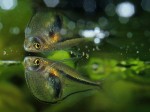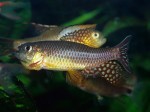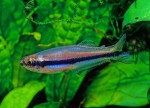by Stefan K. Hetz, Berlin
The tetras (Characiformes), also called characins for short, are an order of bony fishes. The order comprises over 2000 species. Tetras are mainly found in South America (approx. 80% of the species) and in Africa, which can also be interpreted as a biogeographical indication of the formation of the continents. Other smaller natural occurrences of tetras are restricted to Central America and the southern parts of North America. Some species – according to literature – are said to appear as neozoa on other continents as well.
Many – but by no means all – species of tetra are relatively easy to recognise by their adipose fin. This small fin – if present – is located just in front of the caudal fin. For example, species from the Lebiasinidae (slender tetras) and Gasteropelecidae (hatchetfishes) families lack the adipose fin. The possession or absence of an adipose fossa is therefore not suitable as the sole identification characteristic for tetras. However, one characteristic – and everyone agrees on this – applies to all tetras: the absence of barbels, i.e. small, elongated protuberances in the mouth area, often equipped with receptors.
Tetras have a certain commercial importance as aquarium fish (about 40 species are regularly offered in the trade) and as food fish (about 10 species). Some of the tetra species used as food fish are now commercially bred in fish farms, where they are very popular because of their fast growth, good food conversion and tasty meat. The many species traded as aquarium fish are usually relatively small (4 to 8cm), whereas some predatory species can reach lengths of around 80cm. These species are at the top of the food pyramid, so it is not surprising that such species specialise in energy-rich foods such as fish.
Tetras of the species Hydrocynus vittatus grow up to 80cm long in a slow-flowing river, the Chobe River, in northern Botswana and are therefore sought-after fishing trophies for angling tourists. The dentition of this predatory tetra is interesting. The teeth protrude beyond the lower and upper jaws when the mouth is closed.
Interestingly, among the tetras one also finds true small forms. These are not limited to individual families but are found in all kinds of families, such as the glandulocaudine tetras or the bottom tetras. Some animals show reductions in characteristics, which are interpreted as so-called paedomorphic characteristics, such as a lack of scales and/or pigmentation as well as missing or differently formed fins. Many small forms of the tetra are found in extremely hostile biotopes, such as the edge of water bodies or the water film above floating vegetation, which is only a few millimetres deep. In Bolivia a year ago (2007) I was able to find several forms of tetras – this was only possible because I had the finest-meshed hand net of all the participants on the trip – sewn by my wife! Among the tetras was also the species pictured. This unknown, adult tetra of about 15mm was caught in September 2007 in a lagoon in the area of the Rio St. Martin in the Bolivian province of Beni. With by-catches of commercially imported fish species, rarer small or very small tetra species also come to us time and again.
Tetras inhabit the different water layers in the biotopes: Bottom-dwelling tetras have reduced swim bladders and so can only maintain themselves in the open water layers with effort and constant fin movements, which can also be observed in the aquarium. In the aquarium, however, they usually sit leaning on their pectoral fins on elevated places on the bottom or on plant leaves and observe their surroundings attentively.
Most of the tetra species on the market are inhabitants of the middle water layers. They usually move slowly through the aquarium alone or in small groups and sometimes also occupy small territories, which some species defend vehemently against conspecifics – especially when they want to spawn.
Behaviour and diet
The representatives of the hatchet-bellied tetras belong to the distinctly surface-dwellers within the tetras. These animals have a straight dorsal line and usually stay only a few millimetres below the water surface. Their overhanging mouth is particularly suited to picking up food from the water surface. With the help of their relatively large and – due to strongly developed pectoral muscles – particularly strong pectoral fins, they are able to actively break through the water surface and capture fallen plant seeds and small insects.
It is discussed by some authors that these animals can fly actively, which can be well imagined from the large pectoral muscles. Interestingly, these animals show parallels in behaviour and morphology to some other tetra groups, such as the goiter tetras of the genus Triportheus, which also have quite large pectoral fins. The suspicion is that this adaptation could be related to the near-surface acquisition of food. Especially Carnegiella myersi, a small hatchetfish species that only grows to just under 25mm long, sometimes finds it difficult to penetrate the surface of the water to prey on fruit flies (Drosophila) because of its size.
The feeding habits of tetras are quite different, depending on their lifestyle. The so-called pencil tetras from the family Lebiasinidae (slender tetras) prefer to pick at plant parts and objects in the water throughout the day in order to take in their food. In the wild, many tetras from the group Tetragonopteridae are immediately on the spot when it comes to preying on potential food. Predatory tetras, such as species of the genus Acestrorhynchus, are ambush hunters that stand relatively quietly alone or in a small group in the water and quickly prey on their prey, which can consist of fish or even small vertebrates or insects that have fallen into the water, in a short spurt. The needle-sharp teeth of the pike-shaped Acestrorhynchus in the picture indicate that it is a lurking hunter.
The term predatory tetra is not used to describe a systematically shot unit but a group of tetras that feed predominantly predatorily.
If you are more interested in the biology of predatory tetras, you should read Kai Arendt’s articles in various aquaristic magazines or, even better, some of his lectures. In the course of time, Kai has made quite a few trips to South America and got to know some species there himself.
Predation, spawning behaviour, brood care
Aquarists do not necessarily associate tetras with the three terms in the headline. Most tetras are regarded – unfortunately still in the pet trade – as typical schooling fish that should be kept in a group of 10 or 20. That this is not always the case can be confirmed by anyone who has observed how the males of some species occupy small territories during the spawning season. In some species, even brood care, i.e. guarding the clutch and the newly hatched larvae, is more or less pronounced.
Male tetras from the family Crenuchidae, such as Poecilocharax weitzmani or Crenuchus spilurus sometimes show threatening and fighting behaviour that is more reminiscent of cichlids than tetras, especially when two males laterally threaten each other with spread fins and lowered gill covers as in the picture.
The breeding behaviour of these two species is also interesting. As with some cichlids, they are cavity breeders. The males guard the clutches and defend the cave – in the aquarium this can be a piece of plastic pipe or a piece of bamboo cane – against conspecifics and suspected predators.
Within the family Lebiasinidae, brood care is widespread. Males of the genus Copella and Pyrrhulina defend territories and even stand fanning the eggs with their fins during brood care. They have even been observed palpating the eggs with their mouths, even removing unfertilised, fungal eggs like Pyrrhulina zigzag in the picture (male on the left).
Direct sperm transfer is also a special form of reproduction. Every aquarist knows the viviparous toothcarps, but very few know that similar forms of mating also exist in tetras. Now, no tetras with gonopodium have been found yet and viviparous tetras are not known to science either, but the reproductive type of some tetra groups is at least similar.
Some tetras from the subfamily Glandulocaudinae, such as the Mimagoniates species shown opposite, possess the ability to transfer spermatozeugms, i.e. regular sperm receptacles that are inserted into the female cloaca during mating, where they ensure the insemination of the eggs as they emerge from the female’s sexual orifice.
These few examples from the large group of tetras can only show you a very small proportion of this diverse group of fish. If you are more interested in tetras, why not join the IG BSSW and support us with tetras? Within the tetra enthusiasts there is a lively exchange of experiences and fish species that are not readily available in the trade. Interested? Then fill out the IG BSSW membership application right away.
For a more comprehensive overview of tetras, see the more detailed literature on this website. If you want more detailed information about the systematics of tetras and also want to look at some pictures of the animals, you can find it in the Salmlernetz by Rainer Massmann.
——————————————
… articles and literature on tetras.








